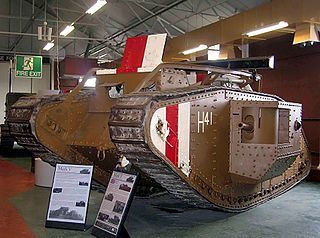
An armoured fighting vehicle or armored fighting vehicle (AFV) is an armed combat vehicle protected by armour, generally combining operational mobility with offensive and defensive capabilities. AFVs can be wheeled or tracked. Examples of AFVs are tanks, armoured cars, assault guns, self-propelled artilleries, infantry fighting vehicles (IFV), and armoured personnel carriers (APC).

A tank is an armoured fighting vehicle intended as a primary offensive weapon in front-line ground combat. Tank designs are a balance of heavy firepower, strong armour, and good battlefield mobility provided by tracks and a powerful engine; usually their main armament is mounted in a turret. They are a mainstay of modern 20th and 21st century ground forces and a key part of combined arms combat.
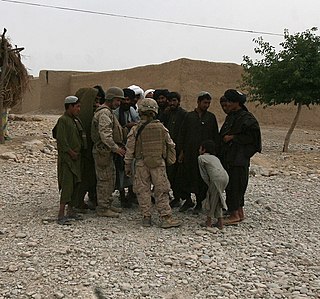
Military intelligence is a military discipline that uses information collection and analysis approaches to provide guidance and direction to assist commanders in their decisions. This aim is achieved by providing an assessment of data from a range of sources, directed towards the commanders' mission requirements or responding to questions as part of operational or campaign planning. To provide an analysis, the commander's information requirements are first identified, which are then incorporated into intelligence collection, analysis, and dissemination.

In military operations, military reconnaissance or scouting is the exploration of an area by military forces to obtain information about enemy forces, the terrain, and civil activities in the area of operations. In military jargon, reconnaissance is abbreviated to recce and to recon, both derived from the root word reconnoitre.

A combat engineer is a type of soldier who performs military engineering tasks in support of land forces combat operations. Combat engineers perform a variety of military engineering, tunnel and mine warfare tasks, as well as construction and demolition duties in and out of combat zones.
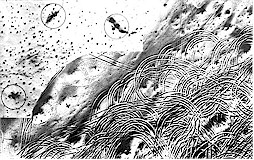
The Battle of Longewala was one of the first major engagements in the western sector during the Indo-Pakistani War of 1971, fought between assaulting Pakistani forces and Indian defenders at the Indian border post of Longewala, in the Thar Desert of Rajasthan. The battle was fought between 120 Indian soldiers accompanied by four Hunter fighter aircraft and 2,000–3,000 Pakistani soldiers accompanied by 30–40 tanks.

The Israeli Combat Engineering Corps is the combat engineering forces of the Israel Defense Forces.
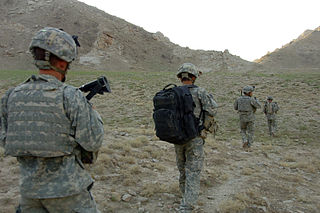
Long-range surveillance (LRS) teams were elite, specially-trained surveillance units of the United States Army employed for clandestine operation by Military Intelligence for gathering direct human intelligence information deep within enemy territory. Classic LRS employment is to infiltrate deep into enemy territory, construct hide and surveillance sites, and provide continuous surveillance/special reconnaissance of an intelligence target of key interest.
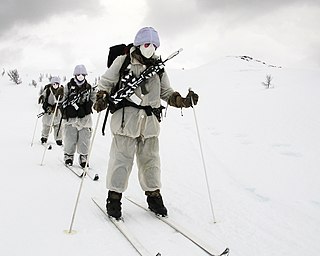
Cold-weather warfare, also known as arctic warfare or winter warfare, encompasses military operations affected by snow, ice, thawing conditions, or cold, both on land and at sea, as well as the strategies and tactics used by military forces in these situations and environments.
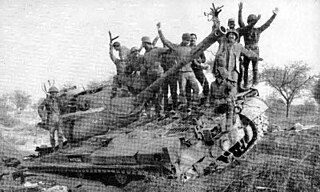
The Battle of Basantar, also known as the Battle of Shakargarh or Battle of Barapind, was one of the vital battles fought as part of the Indo-Pakistani War of 1971 in the western sector of India. The Indian troops won a hard-fought battle that secured this area in the Punjab/Jammu sector. The name Battle of Basantar actually encompasses the entire gamut of battles and skirmishes fought in the Shakargarh sector.

The United States Marine Corps Reconnaissance Battalions are the reconnaissance assets of Marine Air-Ground Task Force that provide division-level ground and amphibious reconnaissance to the Ground Combat Element within the United States Marine Corps. Division reconnaissance teams are employed to observe and report on enemy activity and other information of military significance in close operations. The Military Occupational Specialty code for Reconnaissance Marine is 0321.
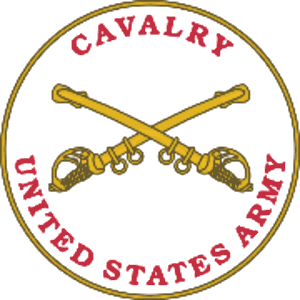
Cavalry Scout is the job title of someone who has achieved the military occupational specialty of 19D Armored Reconnaissance Specialist in the Combat Arms branch of the United States Army. As with all enlisted soldiers in the United States Cavalry, the person holding the Scout specialization will still be referred to as a "Trooper", the traditional colloquialism denoted in the cavalry's Order of the Spur.
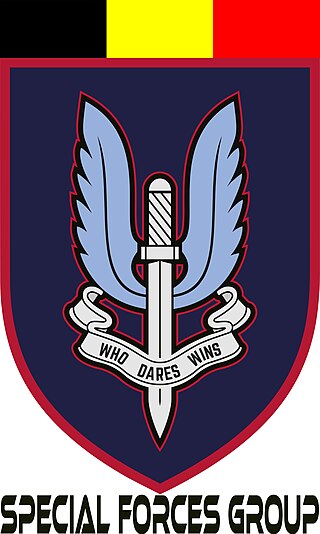
The Special Forces Group is the special forces unit in the Land Component of the Belgian Armed Forces.

Special reconnaissance (SR) is conducted by small units, such as a recon team, made up of highly trained military personnel, usually from special forces units and/or military intelligence organizations. Special reconnaissance teams operate behind enemy lines, avoiding direct combat and detection by the enemy. As a role, SR is distinct from commando operations, but both are often carried out by the same units. The SR role frequently includes covert direction of airstrikes and indirect fire, in areas deep behind enemy lines, placement of remotely monitored sensors, and preparations for other special forces. Like other special forces, SR units may also carry out direct action and unconventional warfare, including guerrilla operations.

The Army Mountain Warfare School (AMWS) is a United States Army school located at the Camp Ethan Allen Training Site, Jericho, Vermont to train soldiers in mountain warfare, the specialized skills required for operating in mountainous terrain. It is home to the 86th Infantry Brigade Combat Team. The school is located in Vermont's Green Mountains.
Engineer reconnaissance is the reconnaissance operations performed by combat engineers to enable forward movement of own troops, in war usually over territory previously occupied by the enemy. The activity includes provision of reconnaissance instructions on the intended route for which a commander needs an engineer reconnaissance report, identification of road and bridge symbols, posting of safe transit notices for identified bridge capacities, estimation for time and materials required to effect route repair, and performance of demolition reconnaissance to identify intended enemy demolitions.
Obstacles to troop movement represent either natural, human habitat originated, constructed, concealed obstacles, or obstructive impediments to movement of military troops and their vehicles, or to their visibility. By impeding strategic, operational or tactical manoeuvre, the obstacle represents an added barrier between opposing combat forces, and therefore prevent achievement of objectives and goals specified in the operational planning schedule. The constructed obstacles are used as an aid to defending a position or area as part of the general defensive plan of the commander. The obstacles that originate from the human habitat can be converted by troops into constructed obstacles by either performing additional construction, or executing demolitions to obstruct movement over the transport network, to create a choke point, or to deny traversing of an area to the enemy. The natural obstacles can be used defensively by securing a more difficult to breach defensive position by for example securing a flank on terrain that is deemed impossible to traverse, thus denying the enemy an ability to close into combat range of direct fire weapons.

The Special Forces Qualification Course (SFQC) or, informally, the Q Course is the initial formal training program for entry into the United States Army Special Forces. Phase I of the Q Course is Special Forces Assessment and Selection (SFAS). A candidate who is selected at the conclusion of SFAS will enable a candidate to continue to the next of the four phases. If a candidate successfully completes all phases they will graduate as a Special Forces qualified soldier and then, generally, be assigned to a 12-men Operational Detachment "A" (ODA), commonly known as an "A team." The length of the Q Course changes depending on the applicant's primary job field within Special Forces and their assigned foreign language capability but will usually last between 56 and 95 weeks.

The School of Engineers is part of the South African Army Engineer Formation, which provides combat engineering corps training and teaching to military officers and personnel as well as other Military Schools throughout the South African National Defence Force. They are currently the only Military School in Southern Africa to formally present IEDD.
















